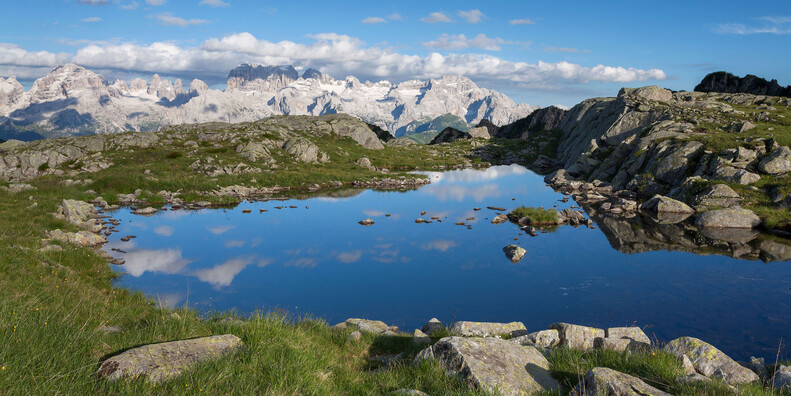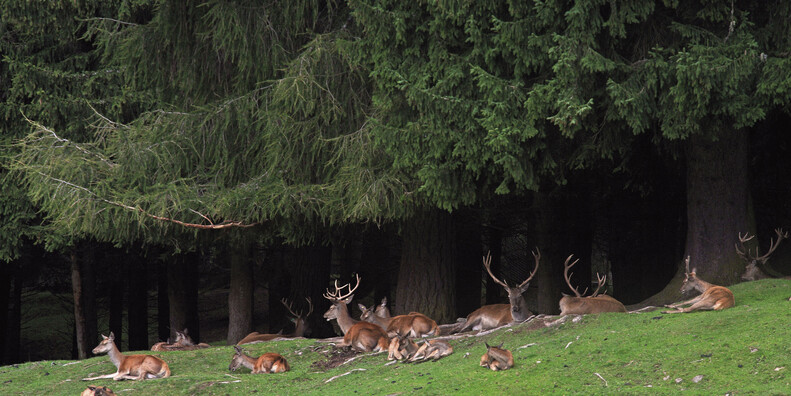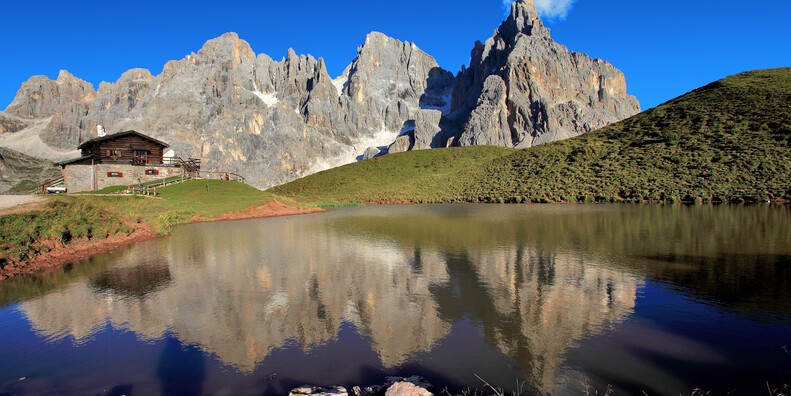A LAND WITH A GREEN HEART
Green districts, start-ups and advanced research; alternative energies for heating, lighting and transport; extensive bike-sharing services; climate houses and certified timber. In Trentino, living more sustainably is a reality pursued in many communities.
Over time, the need to safeguard Trentino’s extraordinary environmental heritage has become a powerful stimulus for the development of new ways of designing, producing and selling goods and services that are able to combine innovation and environmental sustainability. Today, Trentino can boast a system of world-class technological and manufacturing expertise in the field of green technology, particularly in the areas of sustainable building and timber, renewable energy and the so-called smart technologies linked to sustainable mobility.
In Rovereto, inside the former tobacco factory, the Manifattura Project - Green Innovation Factory brings together fifty companies, mainly start-ups, in the fields of sustainable construction, renewable energy, technologies for managing and monitoring the environment and natural resources, and the circular economy.
Another flagship initiative is Habitech, the Trentino Energy and Environment Cluster, which seeks to combine the expertise of universities, laboratories, research organisations, companies and institutions. It comprises more than 300 companies, research institutes and public agencies.
The forests of Trentino, 76% of which are publicly owned, form a landscape that is the result of the centuries-old relationship between the local community and its forest heritage. Dense and homogeneous, they cover more than 63% of the territory and supply 43% of the national timber production. For many years, Trentino has prided itself on its industry-leading management and certification system for the forest-timber supply chain, which certifies that wood comes from sustainably managed forests. More than 270,000 hectares of Trentino’s woodland are PEFC certified. Thanks to extensive, careful forest management, wood from Trentino’s forests is high-quality wood, with an especially dense and strong fibre, making it particularly suitable for use in construction: larch trunks from the forests of Val di Fiemme still support the city of Venice today. The Fiemme Building System (SOFIE) for timber buildings was developed at the San Michele all'Adige site of the National Research Council's Institute for the Development of Wood and Tree Species (IVALSA), with some of the most impressive biological and earthquake-proof criteria. And ARCA, which stands ARchitettura–Comfort–Ambiente (Architecture-Comfort-Environment) has also been developed in Trento: it represents Italy’s first certification system for high-quality timber buildings and components.
Trentino Tree Agreement, how forests are being reborn after Vaia
On the night of 29 October 2018, Storm Vaia hit the forests of Trentino, causing around 4 million cubic metres of trees to be blown over due to the exceptional force of the wind. Healing that wound inflicted on an element – the forest – that is such an integral part of the landscape, history and identity of the people of Trentino, as well as the experience of thousands of guests who visit our area, was the commitment immediately undertaken by the Trentino community. This led to the creation of the Trentino Tree Agreement, an environmental awareness and communication project conceived, at the instigation of the Autonomous Province of Trento, by Trentino Marketing, the Department of Agriculture, Forestry and Soil Defence, the Provincial Forestry Agency and MUSE (Science Museum), but also a fund-raising initiative run by the Autonomous Province of Trento to restore forests that had been destroyed. For the past four years, an army of supporters has been contributing to the growth of one or more trees planted in three state forests: Foresta dei Violini in Paneveggio (26.4 hectares), the Foresta dell’Eremo in San Martino di Castrozza (20.5 hectares) and the Foresta Nascosta in Cadino (25 hectares). With these funds, in the area known as “Costa Bocche” in Paneveggio State Forest, 20 enclosures of about 2,000 square metres each have been built and about 2,000 seedlings planted inside them. At this stage, the focus was also on the creation of new paths to follow in complete freedom and safety and at a slow pace to fully appreciate the flourishing of nature and to remind us of the beauty of rebirth.
www.trentinotreeagreement.it
Biomass
The local availability of wood chips derived from sawmill waste, forestry offcuts and cuttings, to heat and light private residences, the service sector and tourist facilities, has led to the construction of numerous district heating plants, located in areas with no mains gas. Thirty-three municipalities in Trentino are currently equipped with district heating plants running on biomass.
Shooting a film in a sustainable way
In 2017, the Trentino Film Fund and Commission launched T-Green Film, a new tool to encourage environmental sustainability in the film industry. Thanks to T-Green Film, the first regional fund in Europe that rewards and certifies film productions that work in an environmentally friendly way was launched.
Recycling
Produce less waste, recycle more and more, use waste appropriately and manage landfill sites that are nearing closure: these are the guidelines of the new Provincial Waste Disposal Plan. The results are encouraging and show an overwhelmingly positive situation in terms of recycling, which has risen in Trentino from 21.3% in 2002 to 76.2% in 2021 with respect to the total urban waste produced, representing more than 468.5 kg per inhabitant. In the provincial capital of Trento, the percentage is around 80%.
Sustainable travel
In September 2017, the Autonomous Province of Trento approved the new Provincial Plan for Electric Mobility. The objectives include supporting the construction of charging infrastructure, incentivising the purchase of electric vehicles and ideally also electric energy used for mobility (from bicycles to freight transport); increasing the number of charging stations, expanding the public bike-sharing service as an extension and supplement to Local Public Transport in the most densely populated areas or those most visited by tourists. Currently (2021 data), there are about 150 charging stations in Trentino. On the Trentino section of the A22, there are 3 charging stations with 6 charging points.
More than 100 accommodation facilities have electric car charging facilities for their guests. The Trentino Guest Card, which each guest can receive by staying in one of the approximately 1,500 affiliated accommodation facilities, also includes charging at numerous public and affiliated charging points.
Trentino ranks among the top territories in Italy for sustainability
Trentino is one of the leading territories in Italy driving the national green revolution: this is what emerges from the CERVED Sustainable Italy 2021 report. The CERVED Group report considered three sustainability factors – environmental, social and economic – and compiled no less than 280 indicators. The province of Trento came fifth for overall sustainability, second for environmental sustainability, second again for social sustainability and 14th for economic sustainability. The 2021 edition of the Report places Trentino Alto Adige in the leading position at regional level.
A strategy for the sustainable development of Trentino
On 25 September 2015, the United Nations (UN) adopted the 2030 Agenda to promote universal, cross-cutting and integrated sustainable development. The Agenda comprises 17 Sustainable Development Goals (SDGs), together with 169 Targets involving five key areas, the so-called 5Ps: People, Planet, Prosperity, Peace and Partnerships.
One of the tools that the Autonomous Province of Trento has most recently put in place is the Provincial Strategy for Sustainable Development, a planning document that looks ahead to 2030, adopted following a wide-ranging process of discussion and sharing that involved the whole of Trentino’s civil society – its institutional stakeholders, the business community, associations, research and innovation centres, schools, universities and all citizens.
The model outlined in the document is that of an integrated territorial development of urban, rural and mountain areas, which promotes cohesion and reduces disparities, prevents imbalances and makes sectoral policies more coherent. The adoption of a Sustainable Development Strategy is also a prerequisite for access to European funds. An additional tool is the Provincial Environmental Energy Plan, which aims to reduce climate-changing emissions by 55% by 2030 compared to 1990.
Even snow is becoming more sustainable
Aware of how important the journey towards sustainable development is, Funivie Pinzolo, one the first ski slopes in Italy to obtain – back in 2004 – the ISO 14001:20015 Environmental Certification for the management of ski lifts, ski slopes and snowmaking systems, obtained the “Si Rating” integrated sustainability certification from ARB S.p.A. in 2022. The certificate recognises Funivie’s focus and commitment to improving environmental, social and good governance (ESG) impacts, while pursuing the 17 goals set by the United Nations in the 2030 Agenda (SDGs).
The same certification was also achieved by Funivie Seggiovie San Martino srl in 2021. Indeed, in Primiero, using a ski lift, switching on a light in a room or the heating in an apartment, travelling by electric car or simply recharging your smartphone means respecting the environment, as only clean energy from renewable sources is used in this area. Both water and wood are valuable resources in which the area is rich, and which enable as many as 14 hydroelectric power plants and two biomass power plants to operate. In the San Martino di Castrozza-Passo Rolle ski area, in winter as in summer, gondolas, cable cars and chairlifts run solely on hydroelectric power, while the same form of power is also used to set the snow cannons into action.
The Pontedilegno-Tonale Consortium, meanwhile, has drawn up its first sustainability report, a vital tool for reporting on the activities carried out and the impacts generated in economic, environmental and social terms. It takes into account both the actions carried out by the Consortium and its associates: the three companies that manage the lifts (SIT SpA, Carosello Tonale SpA and SInVal srl), the two hotelier associations, the ski schools and the five local municipalities. The use of renewable energy sources for energy production (hydroelectric and photovoltaic) has been particularly successful: in the three-year period 2019-2021, the energy consumption of the entire territory was covered and a surplus used externally was also produced. Among the Consortium’s various future goals, in line with Agenda 2030, is a commitment to foster the emergence of renewable energy communities.
In the winter season 2019-2020, the Pejo 3000 ski area, within the Stelvio National Park, was the first to ban plastic products. So, it’s farewell to plastic crockery, cups, disposable straws and bottles in mountain huts. There are information panels to raise awareness among skiers, encouraging them to limit their use of plastic, starting with packaging and plastic bottles, and encouraging them to take their waste back with them.
You can find out more information by following this link




